Review Nokia 5140 Nokia 5140, live
pictures
Nokia 5140, official
pictures
Standard kit
- Phone
- Charger
- User's guide
- Headset

For a certain number of years the Nokia Company was the only one
to produce the phones in the pseudo-protected manner. These phones
were of so-called "outdoor" segment (Active are the other
names for it). These products were always in a moderate demand.
New Nokia 5140 is not an exception out of this rule; this phone
will carry on the traditions started by Nokia
5210 and 5100.
Nokia 5100 is easy to recognize, its resemblance with the older
models was emphasized on purpose in the phone’s design. Technically
wise, the phone is based on the platform 40; the user will not see
in it any extraordinary features. The secret here is that the Nokia
model will not enter the market alone; it will appear with its rival
Siemens M65. This is not a joke for the group in which these phones
will be represented-there might not be enough purchasers for both
models, which will lead to the great challenges and competitiveness.
Let us consider the pros and against of Nokia 5140 to estimate its
market prospective.

The phone’s design accentuates the resistant qualities of the phone:
layers of the rubberized plastic on the sides, latch covering the
interface connector, padding over the battery. Everything taken
together gives an impression of the total protection of the phone
from any disasters. Of course, when compared to the regular phone,
the protection level is higher. I would not recommend though smashing
the phone against the wall on purpose or throwing it out of the
window-the phone might not stand such treatment. Plunging the phone
into the bucket of water automatically means saying “good bye” to
it forever. Do not forget that the phone is of pseudo-protection,
which means that the phone was not designed for a lifestyle inspired
“too much” by sports. Actually, there are very few phones with the
real protection; Nokia
6250 was the only one of the series models. However, for many
users such protection is satisfactory; these models are normally
purchased for the summer camping, mountain skiing or some other
entertainments of this sort. It is remarkable that in most cases,
this phone becomes a second one for a user.

Normally, the phone is equipped with the flashlight located on
the upper butt-end; you can activate it out of the stand by mode
by pressing the # key. The flashlight does not work with the locked
keyboard. It is not very clear why it was done so and you have to
unlock the keyboard before using the flashlight. The power on/off
function is also located on the upper butt-end; you can quickly
change the profiles at the stand by mode using it. This key is installed
deep inside and it is a bit troublesome to press it.

The phone has almost the same dimensions as the previous model
(106.5x46.8x23.8 mm). Its weight is 101 gr.
On the external panel, you can see a round white window-it is a
level. If you put the phone into the horizontal position, on the
table, for example, the slope of it will be identified. The level
is necessary because of the integrated digital compass. The function
is worth of additional comments, so I will come back to it later.
The phone’s display is just like in any other model of the 40 series;
the matrix is the STN one; there are 4096 colors, the colors’ reflection
is rather pasty. Such displays look outdated to the average consumer;
they cannot even compete on the market with the present phones.
Two years ago, such displays were more or less acceptable, but now
even the low-end phones are equipped with the similar or even better
displays. The display can read up to five text lines and one information
bar.


Technologically wise, the phone is identical with Nokia 5100. The
design of the phone is such that all the key and operating elements
within it are fixed very close to each other. On the one hand, this
increases the level of water resistance; on the other hand, you
have to make an extra effort when pressing the keys. The volume
control keys on the sides and the PTT button on the right side are
a bit stiff. This has to be taken as a special feature of the phone.
The backlight works through special LED located at the sides of
the keys themselves. The signs on the number keyboard are very well
distinguished in any conditions, which certainly is an improvement
as compared to the previous model.

To open the frame case you have to press into the two side curves
and then push with forces. The basic block is moderately hermetic,
but subjectively the imminence of the rims here is worse than in
Nokia 5100. Partially this is connected with the lack of the expanding
spring on the sides, here they are replaced with plastic (a more
economical solution to the problem although decreasing the safety
level from moisture or from the cuff).


The keypad is removable; it is easy to take it off as a single
block. The keys of the first two horizontal rows are very convenient
for typing; the same is not that much true about the lower rows.
The same thing is fair for the scroll key-on the one hand, it is
handy location and size wise, and on the other hand, fingers get
tired of pressing against the rubber. The classical design of the
keypad taken into account, I would say that it is possible to come
to grips with its inconveniences; there are no distinguishable “pros”
or “buts” about it.

The battery is covered with a special plastic cover; you have to
pull on the catch to open it. The BL-5B lithium-ionic battery of
the 760 mAh capacity is used in Nokia 5100. The manufacturer claims
that the phone can work from 150 to 300 hours at the stand-by mode
and from 2.5 to five hours at the talking mode. The phone worked
in the Moscow MTS-network five days in a row with the functions
maximally is use-calls up to 45 minutes duration, the 25 minutes
menu navigation and work with SMS. As the synthetic test proved,
the switching off the adopted mode for the ring level, inactivity
of the built in thermometer and the flashlight increases the work
time for 8 to 9 hours with the same time of using other functions.
The results are similar with the last year ones for Nokia 5100,
which is rather odd since in the new model the battery of the bigger
capacity is used.

On the backside of the phone, you can find the window for the VGA-camera
that is technologically the same as in the last Nokia models.
Menu
Since this phone is typical for the latest Nokia models, I will
dare to copy here the main description points, while talking in
details only about the new functions of the phone.

The interface of this phone has gone through several changes since
the phone is based on the new 40 platform of the second version.
In all the lists now, there is an option of their presentation in
different ways. By default, it is the name list, but you can also
opt for the common list and for the files demonstration in a way
of symbols. The last mode is very interesting; it is just perfect
for the images and pictures’ representation. The names of the files
are not as important here as the images themselves. In some way
the folders with pictures here are similar with the ones you can
see on PC desktop.
One of the interface’s advantages is the possibility to switch
from one function or another to the other phone’s services. For
example, when choosing an image for the wallpaper, you go through
all the folders and then you install one (or change its colors)
extricating it out of the Option menu using the left soft key. It
is great how the new options appeared in the phone; however, it
would be better if you did not have to confirm your commands by
additional presses that were not necessary before. The impression
of the phone is controversial- on the one hand, the range of the
possibilities enlarged, on the other, all the functions take more
time and efforts, not all the menus are arranged logically, which
also causes difficulties especially for the inexperienced users.
I have to confess that a thought of the lack of Quick or context
menu in the phone (similar to the one used in Sony Ericsson phones)
flashed in my head several times.
Here is the last rather unusual reflection for the fans of Nokia
phones. The choice of this or that function is assigned here to
the joystick and not to the left soft key. Sometimes you tend to
press the left soft key unwillingly, but you find nothing there,
just the blank field. All the various functions taken into account,
I do not see why overloading the menu with different functions while
not using the empty space.
You can call up the menu by pressing the central key then you see
the rows of icons in the main menu. Up to nine icons can fit the
display simultaneously, but if there are more of them (for example,
SIM-Menu) you can scroll down the display. In the case of Nokia
5140, the developers tried to preserve the icons in the overall
style of the phone, however the impressions of this attempt were
divisive. The icons look the same and you loose track of them. There
is always an option of switching the main menu into the standard
mode when you have the icons arranged vertically, having a caption
under each one.
One of the phone’s particularities is such that at the incoming
call the menu (if you are working within it now) disappears and
comes up again once the talk is over. When you dial a number, the
wallpaper wanes and you see the white background instead. This was
not the same in Nokia 6230 and it did cause certain problems with
the font not being very legible. One of the interface’s disadvantages
is that the indicator of the battery charger and of the level of
the signal is not well seen. Depending on the color specter of the
display, these indicators may not be seen at all.
A digital clock- a screen saver-appears on the screen at the stand-by
mode along with the icons of the missed calls, this is certainly
very convenient.
By titling the joystick to one direction or another, you can also
activate different function that definitely eases the work with
the phone. You can assign any function to the right soft key (you
choose out of the suggested list); you can also make a list of the
mostly used menu functions. What's more, you can assign the voice
tags to the ten functions; the phone recognizes the tags very well.
Before talking about the other functions, I want to draw attention
to the phone’s ROM. The capacity is of four Mb.
Phone book. The maximum number of files that you
can save in the phone book is 1000 names. You can attain that many
files if you do not enter too much information for each, but just
one or two fields. If you enter approximately six or seven fields
for every name, you will be able to save no more than 500 files.
As it is clear now, you can insert up to five phone numbers for
a name and choose a type of the number (mobile, business, home,
fax or mostly used one). The first entered number becomes the one
by default; you can change it later if you like. At the first data
insert, you enter the name and one main number only; all the further
operations are conducted later with the help of the editing menu.
Such data entering might not seem very convenient to some of us,
although the others will say that they enter only one number for
one name anyhow and both arguing sides will be right. Taken into
account that the data entering is the same in all the Nokia phones,
it can be firmly asserted that it does not cause any problems.
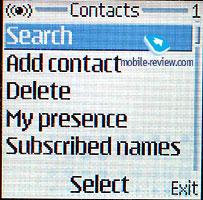 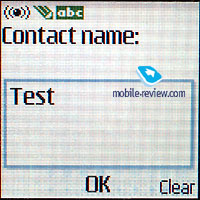
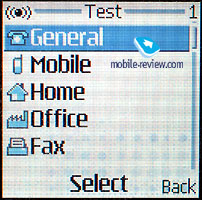 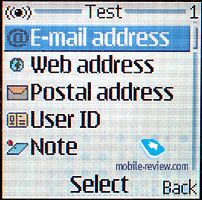
As the additional information for each name, you can enter e-mail
address, web address, mailing address, and some text note. One new
function, the USER ID for the service presence, is truly noteworthy.
This is an ICQ of a sort, since this function tells you which subscriber
out of your list is available at the moment. It is not clear yet
how interesting this function might become.
You can assign a picture for every number (the image mode only
or an automatic photo correction for the convenient size). When
looking through the information for one name, you will not view
the picture automatically; you will have to open a special function
for it. On the other hand, you can set a preview of the name and
the image in the main list. In such mode, the icon is not very big
and does not give a full impression of the picture. Other viewing
modes of this list are standard here just the names or the names
with the numbers. The main list can show the numbers from the SIM-card
memory as well as from the phone’s memory. You can assign up to
25 voice tags to the selected numbers.
 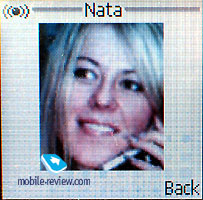
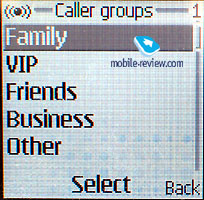
All together, you can assign 100 pictures to the names. At the
incoming call the number of the subscriber is showed along with
his/her picture. On the display, the picture looks a bit bigger
than in the list, although it is smaller than it could be. It will
take you an effort to figure out who it is on the picture since
as the photo diminishes, the image somewhat transforms. Overall,
the picture takes very little space on the display what is logically
inexplicable. Now this function is developed very poorly when compared
to the phones from other manufacturers equipped with this function.
Let us hope, it will be improved soon.
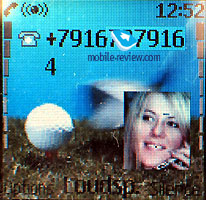
There are five groups of subscribers in this phone, what is not
typical for the Nokia phones. You can assign a melody for each one
of the groups.
I would say that the overall organization of the phone book is
mediocre. On the one hand, there are many fields in it, on the other,
the data entering is more convenient for the PC, but not for the
phone itself. I will stress that the phone book is rather typical
for the Nokia phones; there are no main changes in it. If ranking
the phones for the phone book qualities, I would assign the leading
position to the business phones from Siemens, then I would name
Sony Ericsson phones followed by Nokia only then.
Messages. The phone supports the Nokia Smart Messaging
standard, which means that you can send/receive to/from compatible
phones the melodies as well as the black and white pictures. Apart
from Nokia Samsung, LG and some new Motorola phones, also support
this standard. You can find up to ten image samples in the phone
memory for the purpose of this function. Unfortunately, the company’s
standard sets a limit on the number of users since the alternative
EMS standard is now in a very high demand for it allows you to not
only send the melodies and the pictures, but edit text also. The
popularity of the EMS standard is huge for the European countries
while its negligence in the Nokia product is very disappointing.
In Russia, only big operators have a hold of the EMS support, the
lack or the presence of this standard in regions is not critical.
Probably this moment is worth arguing, but the lack of EMS in Nokia
phones certainly is a minus.

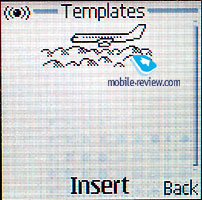 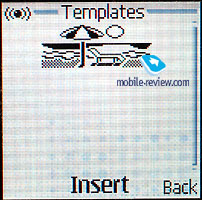
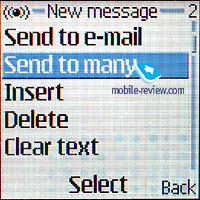
The company supposed that MMS can substitute EMS. The MMS-technology
is becoming ordinary, but it allows to create more pleasant messages,
which include photos, color pictures, melodies and so on. Each messages
can be of 100 Kb. MMS work correctly in the phone without any problems.
The phone is equipped with the built-in mail client, which works
with POP3/SMTP protocols. The client’s possibilities are very limited-it
does not support attachments and the phone recognized Russian encoding
only. When there are no alternatives, you can be satisfied with
this client, but let us hope that the Java attachment will appear
for the platform 40 with the extended possibilities especially granted
that the client described is a Java program.
There are mailing lists for the regular messages where you can
add subscribers to from your phone’s book memory. This is truly
convenient especially if you tend to send alike messages to a number
of your friends or colleagues. Traditionally, there is an option
of using the messages’ samples, of your own folders’ creation and
of sorting out the sent/received messages into these folders.
Call lists. The phone is equipped with three lists
for received, missed and accomplished calls. Each list can hold
up to twenty files. The date and the time of the call are showed
in the list, which is convenient. When in the stand by mode, you
can press the send button to view a list of the last dialed numbers.
Settings. You can activate the profiles in this
menu or turn them on by using the power on/off function. Every profile
can be temporarily activated, for a given interval, and then the
switch to the profile will be done by default. The sound alarms
can be set for all the events; the incoming call for all the calls
or just for the selected groups of users. The profiles’ realization
in the Nokia phones is of the best ones on the market.
The screen settings allow you to choose the display color scheme,
wallpaper, and screen saver. The screen saver is a picture that
is displayed at the stand-by mode with the inactive backlight. It
is more convenient to pick one of the offered pictures since in
this mode they are better seen than the downloaded full color ones.
The interval indicates the amount of working time of the screen
saver; the digital clock will then replace it.
IrDA switching on is available from the settings’ menu as well
as the GPRS-settings.
Among the other settings, the automatic volume control of the dynamic
is noteworthy-the phone automatically chooses the sound level depending
on the present conditions. You will not notice a great sound difference
indoors, although outdoors this function is very useful.
The phone is empowered with the automatic keylock; you can also
set a safety pin number so that nobody could use your phone. For
the accessories’ purpose, there is now a possibility to set “a mood”
of the phone, for example, to choose a profile that will be activated
when the battery charger is on. This is an interesting phone’s feature.
You can tune in the phone according with your wish and necessities.
Gallery. The folders with various files are stocked
here, all of them having matching titles. You can view the folders
as a list, as a list with names or as icons.
Media. All the settings connected with the multimedia
possibilities of the phone are kept here. Let us start with the
Camera. The integrated camera allows you to take the pictures of
the VGA-resolution or in a portrait mode (80x96 pixels). The pictures’
quality on the screen is mediocre. After you send the pictures to
the PC, they look better although you can still wish for the best.
Not that many camera settings are offered; there is a night mode,
three quality types and dimensions types. The format of the saved
files is JPEG.
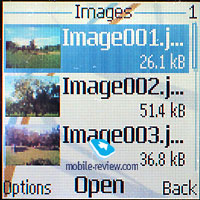 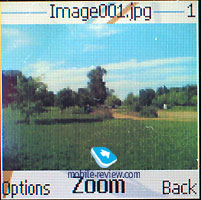
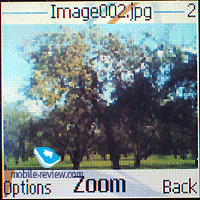 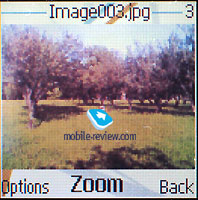
You can make 15 seconds videos of the 3GP format (128x96 pixels
with the AMR sound) with this phone. Here you do not have an option
of setting a maximum duration of the video, as it was in the other
phones. The key here must be the limited memory of the phone.
The qualitiy of the video presented on the screen is not very high;
the sound does not always fit its descriptions and the image on
the screen is dreary and murky because of the display. On the computer
screen, the videos do not look very good either; this function is
rather simply entertaining, and not very meaningful.
The type recorder allows you to tape up to three speaking minutes;
it also works when the phone is on the talking mode. The only limit
to the number of recordings is the phone’s memory.

Radio. The phone allows you to save up to 20 FM radio stations
and to assign text titles to them. This function is identical in
other Nokia phones; key pressing on the headset does the switching
of the saved radio stations. Radio can be played when the speakerphone
is on, but then it is necessary to plug the headset in since it
serves as an antenna. The radio signal can also be used as an alarm
clock, but the headset is then necessary too.
Organizer. You can enter from 100 to 250 files
into the memory-it all depends on their length. There is an automatic
delete of the old files (according to their timely remoteness).
You can view a monthly or a weekly calendar divided by hours; there
is a quick switch to the chosen date. You can enter events of five
different types (appointment, call, birthday, reminder, and memo);
you can set an alarm for every event; the events can be repetitive.
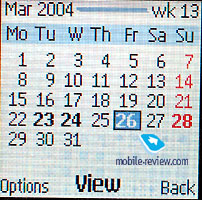 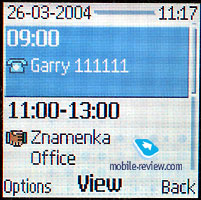
 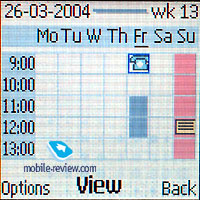
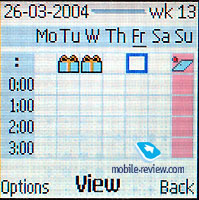 
The list of things to do lets you create the events of three priorities
(high, standard, low) and set a critically important date for each
one of the events.
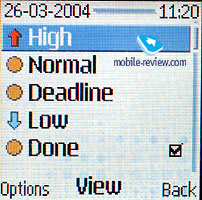 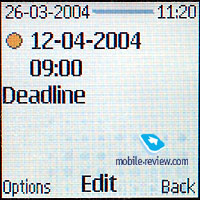

Notes. Every note can hold up to 3000 symbols. Actually, this is
more than enough even for the most fastidious user. Just like in
messages, two types of font are supported.
Digital wallet- this is where you can create a password for keeping
the most essential information such as your credit card requisites.
However, if you loose the phone, the one to obtain it will find
it quite easy to extricate this vital information, so it would be
better if you retain with more important and less risky functions.
You can set only one-time signal with the alarm clock.
Attachments. All the offered Java attachments
are kept here together with such standard functions as calculator,
counter back timer, and stopwatch (with the intervening intervals).
The phone is equipped with one game only; it is Adventure Race,
which is an extreme bicycle riding with various obstacles.

Compass. This is the first time when the digital compass was integrated
into the phone. To set it up, you have to place the phone horizontally
and rotate it with circular movements. If you perform this too fast
or too slowly, the setting up will not be complete. Actually, it
will be difficult to set the compass in the camping conditions since
the flat horizontal surface is needed (that is where “the level”
comes onto the stage). One of the additional functions is the possibility
to command for a slant.
 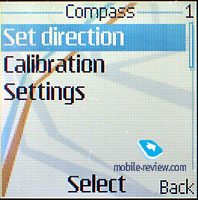
Thermometer. As it is derived from the title, this thermometer
measures the air temperature; the deficiency might be of several
degrees. When you turn on the phone for the first time, you have
to wait for about 20 minutes so that the real values appear on the
display. Overall, the thermometer is rather precise. You can save
the thermometer on the display when in the stand-by mode.
The last unique function is the Sound meter. When choosing this
function, you can measure the sound volume in dB. The manufacture
stresses, however, that this function is not for the professional
use. That is exactly the function that helps to tune in the sound
in the different conditions. The function works well and the volume
change in the speaker is well heard, especially with the great background
noise.
Fitness Coach. This attachment allows you to plan your exercises
and to make a work out schedule. It is very nice how you have to
enter a password for such personal information; the developers thought
it appropriate to keep such information out of the sight. As you
download, you can see a window that warns you that the program does
not guarantee any results-this must be the consequence of the finicky
users’ complaints.
 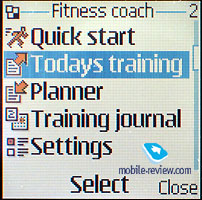
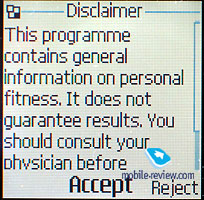 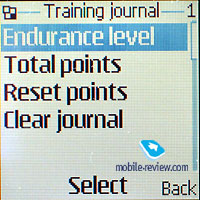
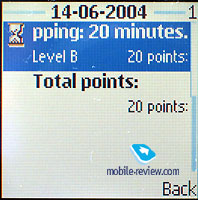 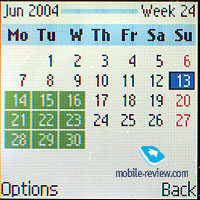
Push To Talk (PTT). Nokia 5140 is one of the first
models to support the push To Talk technology, so it is even more
engaging to see it work. This technology is a walky-talky of some
sort that works with the operator’s support. Thus, you need the
operator’s support on one hand and the activation of this function
if it is there as such.
 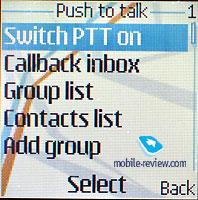

By activating PTT function, it becomes very easy to define the
group of subscribers you will be partners with in using this new
technology. For example, this group might be your family, your colleagues
or somebody else. The function is designed for several groups of
subscribers each of which can include a certain number of the subscribers.
The phone can work only with one group of subscribers at once; the
phone is also catching a radio wave at the same time. As soon as
one of the subscribers from the group presses the key and starts
talking, you hear him/her with a little delay (the speakerphone
mode, you do not have to bring the phone to your ear). Not everybody
can talk simultaneously since this is not a regular walky-talky
connection; it is rather a set of simple sayings broadcasted for
the whole group.
You can opt for the tete-a-tete mode-that is when you choose it
out of menu and nobody of the selected subscriber would hear you
(or vice versa). In this mode, nobody in the group will hear you.
The quality of voice transmitting is striking when comparing the
PTT mode and the GSM-connection-the words said may be mixed with
the background noise and the technical blunders of voice relaying
are well heard. The disadvantage is although compensated by the
low price of this service (5 to 10 dollars for a month with unlimited
time of exploitation). When comparing the different terminals, I
notice that the Nokia phones do not have very powerful speakers
in the PTT mode; the sound is worse than in the models with speakers
designed specifically for this purpose. It is difficult to estimate
now the practical application of the PTT function since the first
networks supporting it will appear for the first time at the end
of this year only.
The key for the PTT activation is located on the right side surface
of Nokia 5140.
Services. The phone supports the complete transition of data of
10 (4+2) class, while the wap-browser is of 1.2.1. version (plus
the xHTML support what makes it partially compatible with the 2
standard). The settings of the wap-browser differ here from the
other Nokia phones with Nokia
6230 being an exception.
Subjectively speaking, the speed of the pages’ downloading in the
browser is not very high; the time for the pictures’ demonstration
is needed; the phone takes time to move on the pages. The Samsung
phones were used here for contrast and it turned out that they take
less time for the downloading of the same pages.

Phone’s productivity. The phone supports Java
MIDP 2.0, so the JBenchmark 2.0 was used to measure the productivity.
The test results were rather striking.
- The overall score 35
- Image manipulation 31
- Text 58
- Sprites 133
- 3D Transform 4
- User interface 51
128x96, Color screen true, number of colors 4096
Total memory 524288
Free memory 220984
Microedition Configuration CLDC 1.1
Microedition Profiles MIDP 2.0
Microedition Platform Nokia 5140/3.06
The comparison with the direct rival Siemens M65 will be mostly
adequate here. The overall score for this model is higher; it is
77. When comparing the different test parameters, it has to be noted
that there is practically no difference in the work with sprites
and the pictures’ transformation within the phone (Siemens scored
144, 35 while Nokia 5140 had 133, 31). On the other hand, the interface
operations take less time when working with Siemens (79 as compared
to 51) and when considering the three dimensional transformations,
it turns out that Nokia has no chances here ( 4 points for Nokia
with Siemens M65 scoring 53). I have to acknowledge, that the display
sizes and the colors reflected have to be taken into account; the
three-dimensional games are worthy of a doubt, so the test result
should not be considered as a negative one, it is just that the
phone is not equipped with this function. The speed of the interface
operations is not that much lower, you normally do not notice that
when working with the phone.
Additional accessories for Nokia 5140 or the GPS-receiver
In contrast with Nokia 5100, the company rejected the idea of changeable
panels for these phones since they were not in a big demand among
users. However, the GPS-receiver is one of the unique accessories
that are available in this phone. This function is inbuilt within
the frame case and when you simply change the panels, you have a
wholesome receiver. The GPS-receiver is charged with the phone’s
battery (the energy consumption is from 30 to 85 mA) and it is an
advantage of a sort since you do not need any additional charging
devices. On the other hand, with the GPS-receiver fully working
with the battery charged, the charge will be good just for a day
and a little more. Taken into account the receiver works anywhere
around the world and even in places where there are no GSM networks
or sockets for the battery charger, you can face several problems.
In this sense, the GSM-receiver working on regular R6 (AA) batteries
or with the compatible battery charger is handier. Of course, there
is a chance that you will be using disposable battery chargers (3-4
charges until they wear out); they are quite expensive but there
are no alternatives to them.

It will take you 90 seconds for the cold start of the receiver-that
will be the first switch on or the work resumption after a long
period of the phone being switched off. The warm start takes up
to 50 seconds that is when the receiver was out of use for no more
than two hours or the GPS-attachment of the receiver was off. The
hot start takes up to 10 seconds that is a perfect timing.
The format of the information received is WGS84, the positioning
precision is up to 25 meters horizontally (the receiver has 12 channels,
the antenna is built in). The phone’s memory is capable of saving
up to 30 channels; the maximum number of channels is 100. Actually,
this is typical for the low-end receiver. There is a function of
channels’ saving; the return to the starting channel, the depiction
of moving speed and of the distance covered. You can send the gained
channels by the SMS, which is an interesting option.

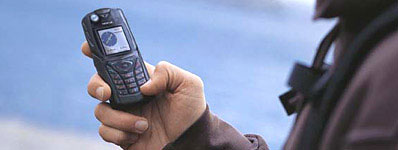
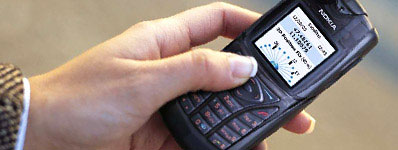

You can obtain a user’s map with the help of Travel Guide Service;
the year subscription of this service comes along with the GPS-Shell.
The maps are available for most of the European countries and in
addition to that, the bonus service lets you search for the restaurants,
museums, and addresses.
As for now, none of the manufacturers has a similar function to
offer. Think of it: if you add this function to the phone, you will
get almost a complete analogue of Benefon
ESC! (it are not on sale any longer). The disadvantage of this
solution is the small display and when on the sunshine the screen
is difficult to manage, which cuts off any possibilities of the
professional use. On the other hand, for the sake of pseudo-extreme
tourism and the camping weekends, the function is very convenient;
you can also share your map with the group of friends (even with
those not equipped with such phone, but with a simple phone and
the standard GPS-receiver).
The price of the GPS-panel depends on the country and varies from
150 to 180 dollars. The price looks acceptable due to the lack of
competing products, however when compared with the standard GPS-receiver,
the price looks rather high. Now you can purchase a professional
receiver for a just bit higher of a price.
The Polar Watch for professionals or simply for the rich Nokia
5140 users.
The Finish Company Polar is one
of the biggest manufacturers producing professional equipment for
sportsmen such as cardio monitors, speed monitors, heart rate monitors
and others. Two Polar products are of interest for the Nokia 5140
users-these are 625X and 725 Polar wristwatch. To be fair, you can
hardly these devices “a watch” since the time telling is the least
of their functions. The first model is designed for those doing
track-it measures speed, slope, load, and heart rate and is even
equipped with a program that allows you to identify the best exercising
level. This model is also equipped with the optional sensors that
let you extend the standard choices. The X-ray port allows you to
send your exercising results to the PC or, as you have probably
figured out already, to Nokia 5140 (then you may send them whenever
you wish using the SMS). The difference of the 725 model is that
it is designed for the bike-riders.
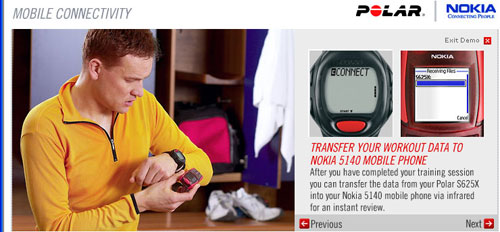
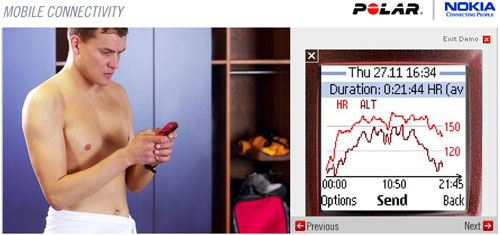
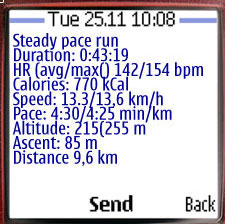
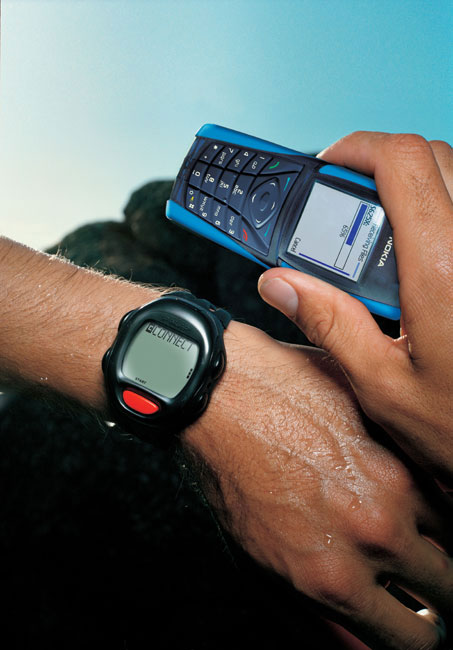
The phone’s display shows you the diagram of the blood pressure
and heart rate and sums up the results of the work out. You will
not have the same possibilities of the analysis of your work out
using solely the phone. However, with the Polar software will provide
you with access to the special website where you can find the work
out schedules and obtain the consultation saving all your information
at the same time.
The Polar watch would override it its possibilities any product
presently put on the market (I am not a professional of this field,
but I did not manage to find anything alike). The price for this
service is high. While the sale price of the first model is about
500 dollars, the price of the second one is 550-600 dollars. It
might be assumed that due to the high price these devices will not
be in a big demand among sport amateurs, but rather among the real
professionals. Well, of course there will be those young people
who simply afford such a toy. Russian market is potentially the
biggest one for such products, however the watch is not on the market
yet, which leaves tempting possibilities to the one to throw it
onto to the market first.
The real rival Siemens M65
As for now there are not that many phones on the market in a protected
frame case designed for the active lifestyle. It is even more surprising
then that such two models entered the market simultaneously. It
is interesting to compare these phones for those thinking of purchasing
one.
Design and protection. Everyone chooses the phone
according to his/her taste, the advice are priceless here. However,
the safety levels can be compared. As Siemens M65 is concerned,
all the technological apertures, for example the ones of the speaker,
are equipped with special water-resistant cloth pads that let the
moisture disappear in case it gets inside. Nokia
5210 was supplied with similar pads but they were rejected later.
Siemens M65 is equipped with the external exoskeleton that looks
like a metal layer and becomes a part of the frame case. In addition
to that, all the apertures look like the interface connector, the
camera has the rubber mufflers of its own. Thus, Siemens M65 is
protected slightly better, although this difference should not become
a decisive factor.
Display. Since the information in the phone is
obtained through the display, it plays an important role. Siemens
M65 has a screen of 132x176 pixels resolution that reflects up to
65000 colors. Due to the big screen size, the phone is bigger as
well-that is something to be kept in mind. As compared to its rival,
Nokia 5140 with the display of 128x128 pixels resolution capable
of 4096 colors reflection looks less appealing.
Memory. Nokia 5140 has a four Mb memory capacity,
while the rival has 11.5 Mb. Granted that both phones are equipped
with cameras and the Java support, the second phone looks more alluring.
Working time. That is where the Siemens phone
looses since the big screen needs more energy and the phone can
work for approximately two days. Nokia 5140 can work up to 4-5 days
at the same rate (and with the same number of talk etc.).
Polyphony. The level of the Nokia polyphony reminds
on the technical level of two years back in time; no improvements
are seen in Nokia 5140. Siemens M65 overrides Nokia 5140 in this
sense.
Special features. Among those, the digital integrated
compass, thermometer and the option of purchasing additional accessories
(GPS-receiver for instance) can be list for Nokia 5140. The most
noteworthy accessory for Siemens would be the little Bike-o-Meter
for bike-rides.
Impressions
The quality of connection is typical in Nokia 5140 especially the
platform 40 taken into account; there are no problems here. The
vibrator is of moderate or even of a weaker force (when compared
to the other phones, the sound in the platform 40 phones is weaker).
The volume of the polyphonic ring is not that high at all; you can
easily miss the call.
One of the Nokia 5140 advantages is a well protected frame case;
there are very few alike phones on the market. Another advantage
is the unique function of compass and thermometer. Judging the more
usual aspects, the phone works long enough after one full charge.
Of course, the GPS-receiver looks great. Finally, the company equipped
the phone with an excellent wholesome IrDA that allows you to send
any melody, picture or video from the phone’s memory to the other
device; the files’ receiving process also works well.
Among the disadvantages, I would name the mediocre display that
cannot clearly show the pictures taken with the in-built camera.
The video function on such screen is useless. The keypad would be
handy for men. Ladies, if you wish to use the phone, forget the
manicure!
Nokia 5140 would be appealing for those skiing, biking, roller
skating and leading the active lifestyle. The users of this phone
will be mostly people of young generation (if judging by the design)
for whom this phone will become a second one (you cannot take it
with you when you are dressed up). Since the price of the phone
was 300 dollars when it entered the market (now its wholesale price
is 260 dollars), we should not expect a blazing success for it.
The additional functions of this phone are not that extraordinary
while the price is fitting for the middle price or business phones.
The experience with Nokia 5100 does not let us wait a noteworthy
price fall for the model discussed.
In March 2003, Nokia 5100 was put on the market with the 300 dollars
sales’ price. In a year and three months, the price decreased by
120 dollars and now its average price is 180 dollars (the wholesale
price is 171 dollars). If we consider the price change in the case
of Nokia 5210, we will see a picture very much alike. All of this
lets assume that the price for Nokia 5140 will fall by 200 dollars
(retail price). There is a little “but” here though-we have to take
into account that the Nokia of 40 series slowly becomes scarce on
the market and the move for a new platform is detected. It is also
not clear how the entrance of Symbian-smartphone of 5000 series
will influence the Nokia 5140 price especially since the Symbian-smartphone
will be empowered with a great number of functions. Let us presume
that the sales’ price of this model upon its entering of the market
will be about 400 dollars and then will fall to 330-350 dollars
in several months. The comparatively small number of the potential
users of these models taken into account we may assume that Nokia
5140 might be simply “devoured” by these new products. All of this
can critically change the price of this phone or just wipe it out
of the market in no time.
It is interesting that now the second protected phone to evoke
users’ interest is Nokia
5100. The phone has the same display as Nokia 5140 but the smaller
memory capacity; besides, its software is not that exciting. However,
the phone is equipped with the thermometer and the volume level
billing, so these phones are alike in this sense. I doubt that the
lack of compass can be counted toward a big disadvantage. Because
of the screen quality, the camera in Nokia 5140 is not a big asset.
The PPT technology could potentially take this phone to a leading
position; however, the lack of the support from the operators crosses
out all the chances.
Siemens M65
will price approximately 300 dollars (with the wholesale of 266
dollars) in July; however, the price decrease will be more dynamic,
what is actually a professional Siemens’ style. These two models
are the great rivals and will be of the same success even regarding
some of the Siemens advantages (that is where the brand’s popularity,
the small market etc. comes onto the stage).
The water-resistant cases for the phones can serve as the alternative
for the phones described; some manufacturers will produce these
cases for the most well known companies. A great advantage of these
cases is that they are universal and practically any phone can fit
into them. The price of such case will be no more than 40-50 dollars;
this case can be plunged into the water (what was not true for the
previous models) and it will protect the phone from smacks and slaps.
This is a great alternative since if you decide to change the phone;
you can always keep the case that will be fitting for the new phone
as well.
To round up on Nokia 5140, I wish to note that the model is nice
primarily for its additional accessories. That is the way for the
future industry and Nokia will be the first one to stress its viewpoint
here. Just imagine that the phone you buy is equipped with basic
functions and only when you buy this or that panel (or a set of
them) you expend the phone’s possibilities to the needed maximum.
On the one hand, this facilitates the process of choosing the phone
and the user has more options, on the other hand, the manufacturer
cuts off the expenses. This means that the production of the basic
version, or of the platform if you kike, will be easier and the
innovations will be needed for the small panels and their technological
possibilities only. With such an approach, the basic block will
serve you for years while the changes will influence only the external
part of the phone. However, this is a matter of the nearest future.
P.S. The software version is 3.06 dated May 1 2004. The blunder
was noted at the assigning of a standard picture to the SMS, the
phone is gets overloaded.
The ring
tone samples (mp3, 190 Kb)
Eldar Murtazin (eldar@mobile-review.com)
Translated by Maria Kapustina (maria@mobile-review.com)
Published — 06 July 2004
Have something to add?! Write us... eldar@mobile-review.com
|



























































